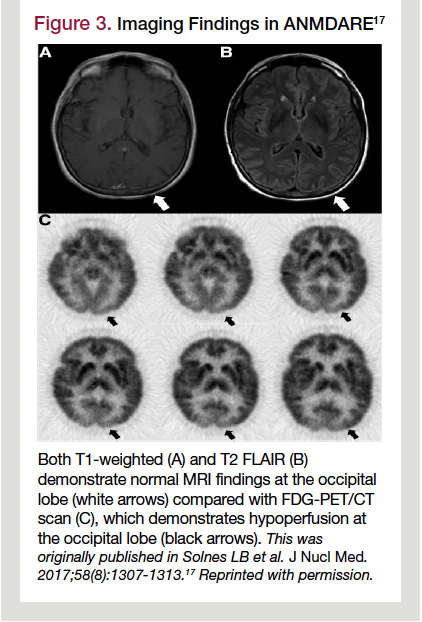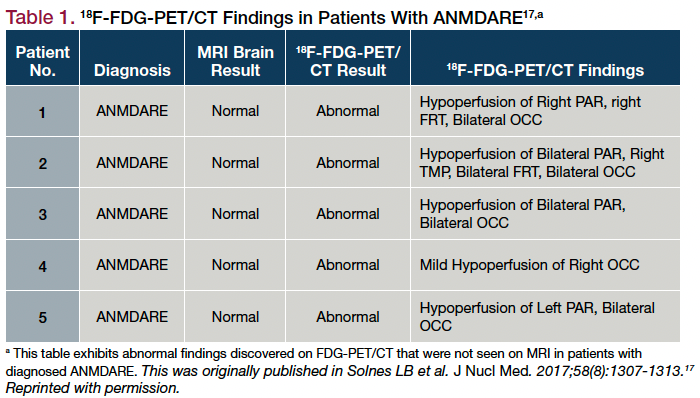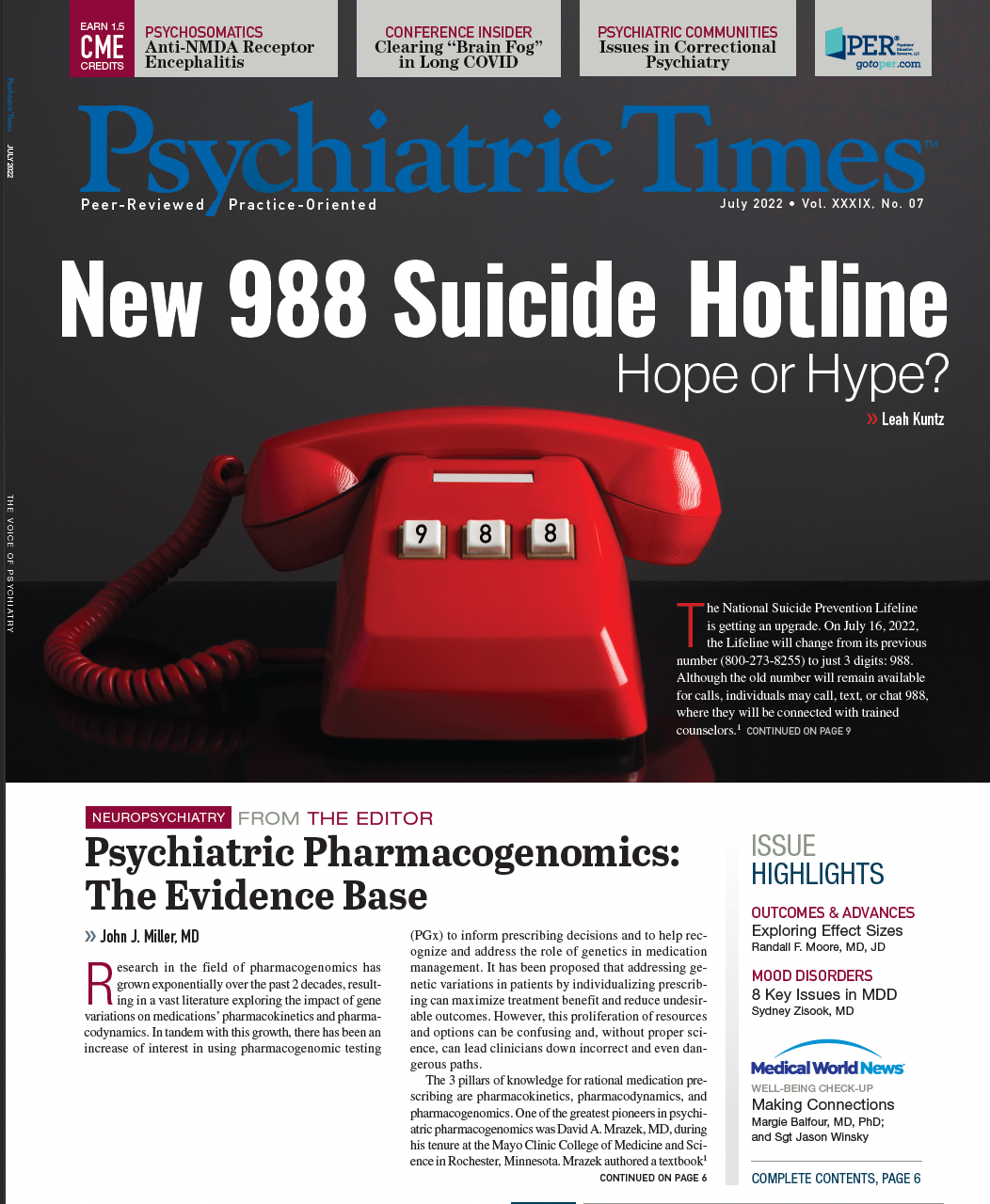Exploring a Medical Mimic: Anti-NMDA Receptor Encephalitis Pathophysiology
In this CME, review the pathophysiology of anti-N-methyl-D-aspartate receptor encephalitis.
VectorMine/AdobeStock

CATEGORY 1 CME
Premiere Date: July 20, 2022
Expiration Date: January 20, 2024
This activity offers CE credits for:
1. Physicians (CME)
2. Other
All other clinicians either will receive a CME Attendance Certificate or may choose any of the types of CE credit being offered.
ACTIVITY GOAL
The goal of this activity is to review the pathophysiology of anti-N-methyl-D-aspartate (NMDA) receptor encephalitis (ANMDARE).
LEARNING OBJECTIVES
1. Understand the pathophysiology of ANMDARE to the cellular level.
2. Recognize the various tools used to diagnose ANMDARE as well as the specific findings seen.
TARGET AUDIENCE
This accredited continuing education (CE) activity is intended for psychiatrists, psychologists, primary care physicians, physician assistants, nurse practitioners, and other health care professionals seeking to improve the care of patients with mental health disorders.
ACCREDITATION/CREDIT DESIGNATION/FINANCIAL SUPPORT
This activity has been planned and implemented in accordance with the accreditation requirements and policies of the Accreditation Council for Continuing Medical Education (ACCME) through the joint providership of Physicians’ Education Resource®, LLC, and Psychiatric Times™. Physicians’ Education Resource®, LLC, is accredited by the ACCME to provide continuing medical education for physicians.
Physicians’ Education Resource®, LLC, designates this enduring material for a maximum of 1.5 AMA PRA Category 1 Credits™. Physicians should claim only the credit commensurate with the extent of their participation in the activity.
This activity is funded entirely by Physicians’ Education Resource®, LLC. No commercial support was received.
OFF-LABEL DISCLOSURE/DISCLAIMER
This accredited CE activity may or may not discuss investigational, unapproved, or off-label use of drugs. Participants are advised to consult prescribing information for any products discussed. The information provided in this accredited CE activity is for continuing medical education purposes only and is not meant to substitute for the independent clinical judgment of a physician relative to diagnostic or treatment options for a specific patient’s medical condition. The opinions expressed in the content are solely those of the individual faculty members and do not reflect those of Physicians’ Education Resource®, LLC.
FACULTY, STAFF, AND PLANNERS’ DISCLOSURES AND CONFLICT OF INTEREST (COI) MITIGATION
The staff members of Physicians’ Education Resource®, LLC, and Psychiatric Times™ and the authors have no relevant financial relationships with commercial interests.
None of the staff of Physicians’ Education Resource®, LLC, or Psychiatric Times™, or the planners of this educational activity, have relevant financial relationship(s) to disclose with ineligible companies whose primary business is producing, marketing, selling, reselling, or distributing health care products used by or on patients.
For content-related questions, email us at PTEditor@mmhgroup.com. For questions concerning the accreditation of this CE activity or how to claim credit, please contact info@gotoper.com and include “Anti-NMDA–Receptor Encephalitis: A Review of the Pathophysiology” in the subject line.
HOW TO CLAIM CREDIT
Once you have read the article, please use the following URL to evaluate and request credit: https://education.gotoper.com/activity/ptcme22july. If you do not already have an account with Physicians’ Education Resource®, LLC, you will be prompted to create one. You must have an account to evaluate and request credit for this activity.
Anti-N-methyl-D-aspartate (NMDA) receptor encephalitis (ANMDARE) is an autoimmune condition caused by reversible internalization of the NMDA receptor as the result of autoantibodies produced via an immunologic trigger.1 The condition was first described in the literature in 2005 by Vitaliani and colleagues,2 with a description of the autoantibodies coming just 2 years later by Dalmau et al.3 Since its discovery, it has become the most common autoimmune encephalitis.1
Epidemiologically, a vast age range (2 months to 85 years) of affected patients has been documented, with a mean age of onset of around 21 years. There is an increased prevalence among younger women than men (4:1); this sex discrepancy appears to even out after age 45 years.4 It is frequently described as a paraneoplastic condition due to its popular association with ovarian teratomas; however, this is not always the case, as viral causes have been documented, as well as undetermined causes. This article reviews the most up-to-date literature regarding the pathophysiology of ANMDARE and provides a brief overview of the clinical features, diagnostic imaging findings, and treatments.
Clinical Features
Figure 1. Clinical Progression and Symptoms of ANMDARE5

The first described cases of ANMDARE involved 4 women diagnosed with comorbid ovarian teratomas and identified a distinguishable pattern of symptoms. The clinical features of ANMDARE can therefore be described as progressive through 3 stages (Figure 1)5:
1. The prodromal stage. This first stage presents with flu-like symptoms, such as headache, fatigue, and low-grade fever.
2. The psychotic stage. The prominent positive and negative symptoms indistinguishable from those seen in schizophrenia (eg, hallucinations, delusions, disorganized behavior, and paranoia) are associated with the second stage.
3. The neurologic. In this third stage, there are more neurological symptoms, such as focal or generalized seizures, dyskinesias, and autonomic instability. Other neuropsychiatric symptoms include agitation, irritability, catatonia, depression, speech dysfunction, and memory loss.5-7 Some patients experience residual neurologic sequelae posttreatment that may last months to years.5
These stages represent the most common progression, but other variations are seen. Below are cases discussed in the literature that exemplify this variety, followed by the pathophysiology as we understand it today and a brief overview of laboratory findings, imaging, and treatment.
Case 1
A 27-year-old woman with no significant psychiatric or systemic medical history presents to the emergency department with a 15-day history of disorganized thoughts, hypochondriacal delusions, auditory hallucinations, insomnia, and short-term memory loss. History of present illness does not reveal headache, fever, seizures, dyskinesia, or autonomic instability. Mental status examination exhibits disorientation to time, abstract thinking deficits, poor attention, speech latency, verbal perseveration, and auditory hallucinations. Initial laboratory studies and imaging are normal; she is admitted to an inpatient psychiatric unit for management of first episode psychosis.
While on the psychiatric unit, the patient displays food refusal, decreased speech, and alternating periods of hypo- and hyperkinetic movement. The initial medication regimen consists of aripiprazole, titrated to 30 mg/day and lorazepam 3 mg/day. Although she shows improvement in her psychotic and behavioral symptoms, her short-term memory symptoms worsen, leading to further neurological work-up.
Brain MRI shows diffuse sulcal enlargement of the cerebellar vermis. Electroencephalography (EEG) shows independent bilateral temporal slow activity without an extreme delta brush pattern. Complete blood analysis is unremarkable. Urine toxicology is negative.
Given the atypical presentation, anti-NMDA receptor antibodies are checked in serum and cerebrospinal fluid (CSF); results of both analyses are positive. All other autoimmune antibodies are negative. CSF also shows mild lymphocytic pleocytosis with lymphocyte predominance. Endovaginal ultrasound shows a mass in her right ovary, which is subsequently diagnosed as an ovarian teratoma.
Further treatment consists of intravenous (IV) immunoglobulin 0.4 mg/kg/d and methylprednisolone 1 g/d for 5 days, which are successful in improving her episodic and visual memory, verbal fluency, and attention as well as in decreasing her psychotic symptoms. Repeated brain MRI and EEG show no specific findings. She is discharged on aripiprazole 30 mg/d, prednisolone 60 mg/d, and monthly IV immunoglobulin 0.4 mg/kg/d for 5 days. Both psychiatric and neurological follow-up reveal marked improvement in all symptoms.8
Case 2
A 23-year-old woman with no psychiatric or general medical history experiences a seizure at home lasting approximately 10 minutes, followed by several minor focal seizures with mouth twitching. She then develops mood instability, increased irritability, and periods of unprovoked and inappropriate laughing and crying. She is admitted to an inpatient psychiatric unit for management. Brain MRI shows T2 and diffusion-weighted imaging–hyperintense (DWI-hyperintense) lesions of the right temporal lobe. The initial treatment regimen consists of valproic acid 500 mg twice daily and olanzapine (unspecified dose).
During her admission, she develops a fever of 37.8 °C and a tonic-clonic seizure despite treatment with valproic acid. At the time of the seizure, vital signs are stable, and she is responsive; however, she is disoriented to time and place. Neurological examination reveals decreased muscle tone in her upper and lower limbs with normal strength. She is transferred to a general hospital for further management. Lumbar puncture is performed, showing herpes simplex virus-1 (HSV-1) polymerase chain reaction immunoglobulin M (IgM) and IgG positivity. Anti-NMDA receptor antibody IgG testing is positive in both serum and CSF. Glutamic acid decarboxylase (GAD) antibodies are positive in serum. Contrast enhanced MRI reveals T2, fluid-attenuated inversion recovery (FLAIR) imaging, and DWI-hyperintense lesions in the right temporal lobe. EEG shows diffuse slow waves in the right temporal lobe. Pelvic ultrasound is negative.
Treatment consists of acyclovir 10 mg/kg IV every 8 hours, methylprednisolone 1000 mg/d IV, and valproic acid 500 mg every 8 hours. Symptoms remain uncontrolled after 7 days, so IV immunoglobulin 0.4 mg/kg/d is added to her regimen. After a second round of IV immunoglobulin therapy, her physical and cognitive symptoms sufficiently improve and she is discharged. Follow-up MRI shows resolution of hyperintense lesions.9
Pathophysiology
NMDA-glutamate receptors are ionotropic receptors that regulate multiple neuropsychiatric functions, including learning, memory, and neuroplasticity.1 They are complexes made up of 4 subunits—2 GluN1 subunits and 2 GluN2 subunits—each with similar structures. These subunits serve as the target for the autoantibodies produced in ANMDARE (Figure 2).
Figure 2. Anatomy of the NMDA Receptor

The NMDA receptor is an ionotropic glutamate receptor that regulates multiple neurologic functions. It is a heterodimer consisting of 2 NR1 subunits that bind to glycine and 2 NR2 subunits that bind to glutamate.1 These subunits serve as the target for anti-NMDA receptor antibodies. Binding of each subunit’s respective ligand activates the receptor and opens the ion channel, which is highly permeable to calcium, and allows the receptor to exert its effects.10
ANMDARE is ultimately caused by autoantibodies that stimulate reversible internalization of the NMDA receptor. This internalization creates a state of NMDA hypofunctionality, which is described in the NMDA hypothesis of psychosis.5 It also is the likely cause of the prominent positive and negative psychotic symptoms. It is most widely accepted that the specific site of autoantibody action is at the GluN1 subunit. These autoantibodies cause crosslinking of the NMDA receptors, altering their ability to interact appropriately, which leads to their internalization and trafficking through endosomes and lysosomes.5,11
Production of these autoantibodies can largely be divided into 3 categories: paraneoplastic processes, viral infections, and unknown. The most common paraneoplastic trigger is ovarian teratomas.1,11,12 It is hypothesized that neuronal tissue expressing the NMDA receptor is contained within some teratomas. These tumor cells undergo apoptosis and release antigen to antigen-presenting cells (APCs), which engulf free antigen and present it to regional lymph nodes. Because antigens are typically intracellular in tumor cells and cannot be easily accessed by APCs, it is suspected the cytotoxic T cells play a role. Herpes simplex virus (HSV) is the most common viral trigger.1,12 It is thought that the inflammatory process of the encephalitis causes neuronal degeneration and formation of inflammatory infiltrates, leading to antigen uptake by APCs or direct delivery to local lymph nodes.
Regardless of the initial immunologic trigger, the downstream effect is the production of memory B cells, activation of naïve B cells via CD4-positive cells, and anti-NMDA receptor antibody-producing plasma cells, which pave the way for NMDA receptor disruption, destabilization, and internalization.1 Once naïve B cells are produced and activated, they enter the central nervous system (CNS) and undergo restimulation due to the high prevalence of NMDA receptors in the brain. This results in the production of plasma cells specific to the NMDA receptor.1,12
Research suggests that it is primarily these antibodies produced by plasma cells already in the CNS that contribute most to development of disease compared with systemic antibodies.12 The site of recognition for the autoantibodies is on the GluN1 subunit of the receptor. The autoantibodies disrupt the stability of the receptor, particularly by interfering with the interaction between the NMDA receptor and EphB2, a protein that functions in a supportive and stabilization role to the NMDA receptor. It is specifically the disrupted interaction between EphB2 and NMDA that leads to displacement and internalization.1,12 Further characterization regarding the mechanism of internalization has not yet been clearly described. Recent studies have begun to explore the possible role of scaffolding and stabilizing proteins in this process, the most notable of which is PDS-95 due to its role in anchoring the NMDA receptor to the cell membrane.1,10
Regarding the progressive stages of ANMDARE, what is known of the current pathophysiology can be correlated to the progression of clinical presentation. The prodromal phase of flu-like illness may be attributed to increased proinflammatory cytokines seen in patients with ANMDARE, such as increased serum IL-2 levels and increased CSF IL-6 and CXCL13 levels.13 The psychotic symptoms seen in the second stage appear to be most likely related to NMDA hypofunctionality resulting from growing numbers of anti-NMDA antibodies and internalization of the synaptic NMDA receptors.14
In later stages of ANMDARE, neurologic symptoms, such as seizures, are the hallmark. Research suggests that during the molecular stages before NMDA receptor internalization, anti-NMDA receptor antibodies act briefly as agonists to NMDA receptors, which lowers the seizure threshold.1,15 This is an important detail regarding pathophysiology, because it reveals that NMDA hypofunctionality does not completely explain the core symptoms. Other NMDA hyperfunctional symptoms include catatonia and dystonia; the same mechanism of brief NMDA receptor agonist activity is theorized to be responsible for these symptoms.15 Finally, many patients with ANMDARE suffer severe cognitive symptoms, which—like the psychotic symptoms—can be explained by NMDA hypofunctionality.14 Decreased NMDA receptor function leads to decreased neuronal activity in the dorsolateral prefrontal cortex, which is required for working memory, cognitive flexibility, and executive planning.14
Diagnosis
ANMDARE can be diagnosed with the use of laboratory tests (both serum and CSF antibodies), imaging (ie, MRI and 18-fluorodeoxyglucose–positron emission testing (FDG-PET), EEG, and the following ancillary tests.
Antibody Tests. The most common autoantibody detected and implicated in the diagnosis of ANMDARE is anti-NMDA receptor. Antibody studies should include CSF analysis.7 Serum analysis for antibodies can be performed, but they are not completely reliable on their own due to false-negative or false-positive diagnosis. Studies have shown that serum analysis is less consistent and has even shown positive results in patients without ANMDARE.7 Specifically in cases of ANMDARE caused by HSV encephalitis, other antibodies have been seen alongside NMDA receptor antibodies, such as GABAA receptor and dopamine 2 receptor antibodies.7
CSF Findings. CSF findings are abnormal in most patients with ANMDARE (80%), mostly in those with late-phase disease. Findings include lymphocytic pleocytosis, normal or mildly increased protein levels, and CSF-specific oligoclonal bands. Depending on the course of treatment, antibodies may be seen only in CSF. The CSF titers may be predictive of prognosis and response to treatment.16
Figure 3. Imaging Findings in ANMDARE17

Imaging Findings. MRI findings are normal in 50% of patients with ANMDARE (Figure 3).17 When findings are present, they are mostly seen on T2 or FLAIR and show signal hyperintensity in the cerebellar or cerebral cortex, hippocampi, basal ganglia, brainstem, frontobasal and insular regions, and sometimes the spinal cord.1,18 These findings are mostly mild/transient and occasionally show contrast enhancement.
Table 1. 18F-FDG-PET/CT Findings in Patients With ANMDARE17,a

18F-FDG-PET/CT scan could be helpful in the diagnosis of ANMDARE in patients with normal MRI findings (Figure 3).17 In a small (n=5) series of cases published by Solnes et al, patients with ANMDARE who demonstrated normal MRI results were all noted to have abnormal 18F-FDG-PET/CT scan results (Table 1).17 Findings included lobar hypometabolism in a wedge-shaped pattern mostly found in the parietal lobe, followed by the occipital and temporal lobes.17 One study found frontotemporal hypoperfusion and brain atrophy.19 Other imaging modalities, such as MR spectroscopy and 9mTc-d,l-hexamethyl-propyleneamine oxime (HMPAO) single photon emission computed tomography (SPECT) show transient cortical and subcortical changes.16
EEG Findings. EEG findings are usually abnormal. The most common finding is nonspecific, slow, disorganized activity, sometimes with electrographic seizures.20 When patients present with catatonia, they show slow, continuous rhythmic activity in the delta-theta range.19 Nonepileptiform seizures may occur and, hence, video EEG may become increasingly important.
Ancillary Tests. ANMDARE often occurs as a paraneoplastic syndrome, most commonly in the presence of an ovarian teratoma. Very rarely, patients may be diagnosed with a different tumor type, such as Hodgkin lymphoma or neuroblastoma.21,22
Important tests for ovarian teratomas include pelvic CT scans, MRI, and pelvic and transvaginal ultrasound. Tumor markers include β-human chorionic gonadotropin, AFP, CA-125, and testosterone. If an oophorectomy is performed, the resected ovaries can show presence of NMDA receptors.16
Other etiologies (aside from tumors) can include infections. Studies have shown positive mycoplasma antibodies, herpes zoster infection, diphtheria, pertussis, tetanus vaccination, and H1N1 vaccination.23-25 Some patients had associated microdeletion of the short arm of chromosome 6 (which included the HLA cluster) antithyroid peroxidase and antinuclear antibodies.26,27
Concluding Thoughts
Despite the amount of research into ANMDARE, a definitive pathophysiologic mechanism has yet to be determined. Most studies investigating the mechanism have pinpointed the most likely pathway as NMDA receptor internalization as the result of autoantibodies, but further details regarding the process of internalization remain unclear. ANMDARE should always be kept in the differential when considering a first episode of psychosis or exploring specific anatomic causes of psychiatric symptoms. Significantly, ANMDARE provides a concrete clinical example of a pathophysiological mechanism first described only 17 years ago that is responsible for the onset of sudden psychotic symptoms.
When correctly diagnosed and treated with immunoglobulin and corticosteroids, ANMDARE resolves and these patients generally rapidly improve. As we continue to understand the complexities of the brain, and as further research reveals more information, it is likely that additional unique pathophysiology will be discovered as etiologic for psychosis, mania, and other psychiatric symptoms. These potential findings may provide pathways for the development of novel treatments to reduce, or even eliminate, these symptoms.
Acknowledgement: The authors wish to acknowledge James A. Bourgeois, OD, MD, for offering suggestions and editing this paper.
References
1. Huang Q, Xie Y, Hu Z, Tang X. Anti-N-methyl-D-aspartate receptor encephalitis: a review of pathogenic mechanisms, treatment, prognosis. Brain Res. 2020;1727:146549.
2. Vitaliani R, Mason W, Ances B, et al. Paraneoplastic encephalitis, psychiatric symptoms and hypoventilation in ovarian teratoma. Ann Neurol. 2005;58(4):594-604.
3. Dalmau J, Bataller L. Limbic encephalitis: the new cell membrane antigens and proposal of clinical-immunological classification with therapeutic implications. Article in Spanish. Neurologia. 2007;22(8):526-537.
4. Tanguturi YC, Cundiff AW, Fuchs C. Anti-N-methyl d-aspartate receptor encephalitis and electroconvulsive therapy: literature review and future directions. Child Adolesc Psychiatr Clin N Am. 2019;28(1):79-89.
5. Dalmau J, Armangué T, Planagumà J, et al. An update on anti-NMDA receptor encephalitis for neurologists and psychiatrists: mechanisms and models. Lancet Neurol. 2019;18(11):1045-1057.
6. Wandinger KP, Saschenbrecker S, Stoecker W, Dalmau J. Anti-NMDA-receptor encephalitis: a severe, multistage, treatable disorder presenting with psychosis. J Neuroimmunol. 2011;231(1-2):86-91.
7. Graus F, Titulaer M, Balu R, et al. A clinical approach to diagnosis of autoimmune encephalitis. Lancet Neurol. 2016;15(4):391-404.
8. Câmara-Pestana P, Magalhães AD, Mendes T, et al. Anti-NMDA receptor encephalitis associated with an ovarian teratoma presenting as first-episode psychosis: a case report. J Psychiatr Pract. 2022;28(1):84-88.
9. Hu S, Lan T, Bai R, et al. HSV encephalitis triggered anti-NMDAR encephalitis: a case report. Neurol Sci. 2021;42(3):857-861.
10. Amedonu E, Brenker C, Barman S, et al. An assay to determine mechanisms of rapid autoantibody-induced neurotransmitter receptor endocytosis and vesicular trafficking in autoimmune encephalitis. Front Neurol. 2019;10:178.
11. Tüzün E, Zhou L, Baehring J, et al. Evidence for antibody-mediated pathogenesis in anti-NMDAR encephalitis associated with ovarian teratoma. Acta Neuropathol. 2011;118(6):737-743.
12. Dalmau J. NMDA receptor encephalitis and other antibody-mediated disorders of the synapse: the 2016 Cotzias Lecture. Neurology. 2016;87(23):2471-2482.
13. Byun J-I, Lee S-T, Moon J, et al. Distinct intrathecal interleukin-17/interleukin-6 activation in anti-N-methyl-D-aspartate receptor encephalitis. J Neuroimmunol. 2016;297:141-147.
14. Masdeu JC, Dalmau J, Berman KF. NMDA receptor internalization by antibodies: a reversible mechanism underlying psychosis? Trends Neurosci. 2016;39(5):300-310.
15. Lynch DR, Rattelle A, Dong YN, et al. Anti-NMDA receptor encephalitis: clinical features and basic mechanisms. Adv Pharmacol. 2018;82:235-260.
16. Dalmau J, Lancaster E, Martinez-Hernandez E, Rosenfeld MR, Balice-Gordon R. Clinical experience and laboratory investigations in patients with anti-NMDAR encephalitis. Lancet Neurol. 2011;10(1):63-74.
17. Solnes LB, Jones KM, Rowe SP, et al. Diagnostic value of 18F-FDG PET/CT versus MRI in the setting of antibody-specific autoimmune encephalitis. J Nucl Med. 2017;58(8):1307-1313.
18. Dalmau J, Tüzün E, Wu HY, et al. Paraneoplastic anti-N-methyl-D-aspartate receptor encephalitis associated with ovarian teratoma. Ann Neurol. 2007;61(1):25-36.
19. Iizuka T, Yoshii S, Kan S, et al. Reversible brain atrophy in anti-NMDA receptor encephalitis: a long-term observational study. J Neurol. 2010;257(10):1686-1691.
20. Dalmau J, Gleichman AJ, Hughes EG, et al. Anti-NMDA-receptor encephalitis: case series and analysis of the effects of antibodies. Lancet Neurol. 2008;7(12):1091-1098.
21. Lebas A, Husson B, Didelot A, Honnorat J, Tardieu M. Expanding spectrum of encephalitis with NMDA receptor antibodies in young children. J Child Neurol. 2010;25(6):742-745.
22. Zandi MS, Irani SR, Follows G, et al. Limbic encephalitis associated with antibodies to the NMDA receptor in Hodgkin lymphoma. Neurology. 2009;73(23):2039-2040.
23. Gable MS, Gavali S, Radner A, et al. Anti-NMDA receptor encephalitis: report of ten cases and comparison with viral encephalitis. Eur J Clin Microbiol Infect Dis. 2009;28(12):1421-1429.
24. Baltagi SA, Shoykhet M, Felmet K, et al. Neurological sequelae of 2009 influenza A (H1N1) in children: a case series observed during a pandemic. Pediatr Crit Care Med. 2010;11(2):179-184.
25. Hofmann C, Baur MO, Schroten H. Anti-NMDA receptor encephalitis after TdaP-IPV booster vaccination: cause or coincidence? J Neurol. 2011;258(3):500-501.
26. Florance NR, Davis RL, Lam C, et al. Anti-N-methyl-D-aspartate receptor (NMDAR) encephalitis in children and adolescents. Ann Neurol. 2009;66(1):11-18.
27. Verhelst H, Verloo P, Dhondt K, et al. Anti-NMDA-receptor encephalitis in a 3 year old patient with chromosome 6p21.32 microdeletion including the HLA cluster. Eur J Paediatr Neurol. 2011;15(2):163-166. ❒

